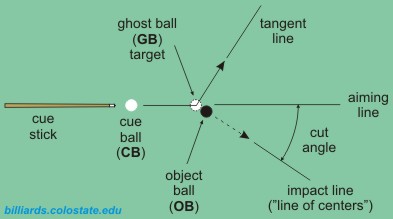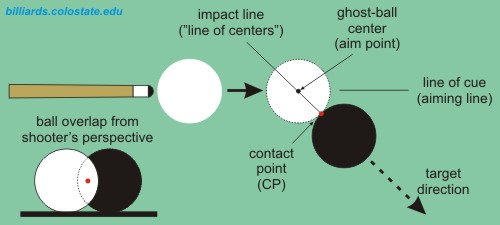cookie:
Thanks for the kind words about my post. It seems as if everyone agrees on the same thing -- simplicity. You mention when being in the zone, you can sight the CTEL, get down on center ball (not sure what that means -- center ball on the cue ball, post-pivot?), and smack the mole in the face -- presumably in the same spot, which for me, is dead-smack center where the ghostball is.
I think where you and I differ, is that I arrive at the fire control solution in one or two less steps. (I'm an ex-Navy guy -- excuse the gun/missile ballistics terminology -- old habits die hard.) I see the ghostball, and I aim right at it, dead center. You have to sight the CTEL first, and then do your pivot (whether in the air or on the table).
I'm not sure if you caught this in my original post:
Now I'm not saying "you can't" or "you don't have the ability," but I am saying, is that I don't need as many steps to arrive at the same fire control solution.
Is it natural ability? Is it a honed ability based on previous "creative" type abilities (e.g. perceptive abilities honed through drawing/sketching)? I don't know. It *has* very nearly crystallized over the years with practice, I can tell you that. I can now not only see the ghostball as part of my PSR (pre-shot routine) when I'm standing over the shot, about to get into my stance, but I can also see the ghostball out of my peripheral vision now. (That was mentioned in my challenge in the previous post.)
Everything, including visual abilities, increase and hone with practice. There are no shortcuts, no matter what anyone tells you. If you practice "it" enough, you will become better at "it," assuming you do everything leading up to "it" the same (i.e. pre-shot routine, head/eye placement, etc.).
Where my hackles get up, is when I get these snake oil sales pitches from "aiming system of the day du-jour" (to include pivot-based aiming systems) where someone will say to me things like these:
* "Sean, with your ability to visualize so clearly something that does not really exist, if you'd learn CTE, your ability will go up "x" number of balls -- you'd be Bustamante speed!"
(I got this one a while ago from a well-known pivot-based aiming advocate, and this one, up until recently, was my "Exhibit A" of the snake oil sales pitch.)
* "Sean, if you know what I know about pivot-based aiming, you'd be ranked number 1!"
(I got this one only recently in a PM, and is now probably going to be my new poster child snake oil sales pitch.)
Now I'll never name names, but these are the examples of things that will get me involved in a CTE discussion. When I see these snake oil sales pitches, I go into the Elmer Fudd "kill the wabbit, kill the wabbit!" stance with my double-barreled shotgun.
If something works for you, great -- that's the name of the game, after all: pocket those balls and get position. I fully believe CTE works for people, if not for the reasons they claim (i.e. it may actually be disguising/BandAiding something wrong in their PSR, head/eye placement, shot line visualization, etc.). But when an aiming system gets foisted upon me or others with these snake oil claims (samples shown above), that's when I'll jump into the fray. And that's where a lot of the perceived skeptics jump in, as well.
Anyway, if I'm ever down your way, I'd like a friendly game of straight pool, if you're ever so inclined. We'll have to make it a race to 150 or 200 though, because I'm already in the 120s for my high run of the year (in June). Not sure how that stacks up for a full-time working man, but hey, I'm pretty proud of it.

Keep shooting 'em straight,
-Sean

